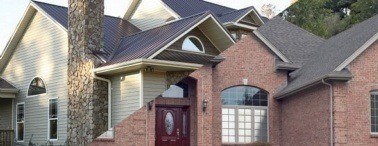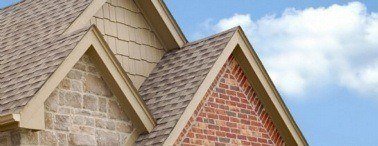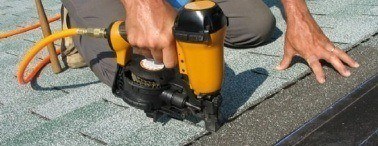
A roof is arguably one of the most important aspects of a home. It’s not just a cover, it’s the guardian of your home. Canada's vast expanse brings a diverse range of climates, each presenting its own challenges for homeowners seeking the perfect roofing material. In this guide, we delve into the top roofing materials suited for each of the 5 Canadian regions, helping you make informed decisions based on your specific needs and the unique weather patterns of your area. Consulting with roofing professionals will also play a pivotal role in determining which roof is best suited for your region.
1. The Atlantic Provinces - Newfoundland and Labrador, New Brunswick, Nova Scotia, and Prince Edward Island
The Atlantic Region, known for its inclement weather including copious rain, strong winds, and heavy snowfall, necessitates roofing materials that offer exemplary durability and resilience; bearing in mind these are some of the regions in which snow can surmount in height, the following options stand out.
- Metal Roofing: Exceptionally robust and corrosion-resistant, metal roofing provides superior protection against the Atlantic's severe weather, particularly heavy rains and strong winds with respect to most other choices. Insulating your metal roof adequately is vital for optimizing its performance. By taking appropriate measures for insulation, you can enhance the roof's functionality, leading to improved performance, reduced energy expenses, and an extended lifespan.
- Asphalt Shingles: One of the more popular roofing choices due to their cost-effectiveness, asphalt shingles are capable of withstanding adverse weather conditions such as high winds, known all too well in the Atlantic provinces. Premium performance shingles, when expertly installed, deliver substantial protection, and are cheaper in price compared to metal roofing.
2. Central Canada - Ontario, Quebec
Central Canada is not only the heartland of Canada but also home to its country’s most extreme temperature fluctuations–its spectrum of weather conditions ranging from frigid winters to hot and humid summers, requiring roofing materials that can effectively adapt to these diverse climatic shifts.
- Metal Roofing: Metal is gaining popularity and is among the chiefmost of roofing materials that can withstand extreme temperature fluctuations; its ability to efficiently shed snow makes it common in regions with denser snow patterns, reducing the risk of heavy snow accumulation. As well, its longevity means that while the initial cost and installation time might be higher than some alternatives, it often proves to be a cost-effective choice in the long term considering the high cost of maintenance for some of its counterparts.
- Asphalt Shingles: This is a very popular choice, due to its affordability and versatility in handling extreme temperature fluctuations. High-quality asphalt shingles, especially those with good insulation, can effectively withstand diverse weather conditions, from heavy snowfall to hot summer heat. They’re also favored for their affordability, ease of installation, and wide range of styles and colors, which makes them suitable for various architectural designs.
- Slate Roofing: Characterized by its aesthetic appeal and remarkable durability, is made of natural stone. Slate tiles can endure harsh weather conditions such as snow and provide insulation for natural heat. The unique sheen of slate roofs comes from the high level of mica in the stone, giving them a brilliant glisten.
- Composite Roofing: This may include materials like fiberglass, plastic, asphalt and recycled paper products. It’s known for its durability and low maintenance requirements. Composite roofing is well-suited for the variable weather conditions in Ontario and Quebec, offering resistance to weather-induced problems such as mold, rot, and UV damage.
3. The Prairie Provinces - Alberta, Manitoba, Saskatchewan
The Prairie Provinces experience a continental climate with cold, snowy winters and warm summers. Known for their open skies, the Prairies can experience dramatic weather events such as thunderstorms and tornadoes, particularly in the warmer months. The best roofs are those that are resilient to harsh weather.
- Metal Roofing: Uniquely suited to resist the region's characteristic storms, metal roofing stands as a particular attractive, robust and durable option. Additionally, the substantial snowfalls in this region underscore the importance of choosing a roofing material that can efficiently shed snow.
- Asphalt Shingles: When augmented with proper insulation, these versatile shingles transcend their economical nature, offering strong protection against the region’s diverse weather patterns.
- Clay Roofing: a traditional and enduring form of roofing, renowned for its aesthetic appeal and durability. Made from natural clay that is kiln-fired to high temperatures, clay tiles are known for their distinctive terracotta color, although they can come in a variety of shades. These tiles are particularly popular in regions with warm climates due to their ability to withstand high temperatures and resist fire. Clay roofing tiles are also favored for their longevity, often lasting for decades or even centuries with proper maintenance.
4. The West Coast - British Columbia
The West Coast experiences a maritime climate with relatively mild, wet winters and dry summers. Although summer is the driest season, this region has significant rain throughout the year. Here are some roofing materials well-suited for this region.
- Metal Roofing: Inherently resistant to moisture, this serves as a critical feature for the region's frequent and heavy rainfall, demanding a roof material that can withstand prolonged exposure to water without deteriorating. This resistance to corrosion is vital in coastal areas where salt spray can be an issue (generally benign for houses near large lakes). Furthermore, its ability to reflect sunlight can help in regulating indoor temperatures, a feature that becomes increasingly important in the face of rising temperatures in cities that receive as much sun as Vancouver during the warmer months.
- Asphalt Shingles: Popular on the West Coast primarily for their durability and effectiveness in wet conditions. They provide a reliable barrier against frequent rainfall and are resistant to moisture-related damage. Their versatility in style and color also allows them to complement the diverse architectural designs found in this region, making them a favorable option.
- Synthetic Slate: With its moisture-resistant properties, is exceptionally well-suited to British Columbia’s damp conditions. It is durable in a climate where freeze-thaw cycles are common. But more than anything for a lot of homeowners, its aesthetic appeal is significant; it offers the classic look of natural slate without the high cost and installation complexity. This makes it a popular choice.
- Clay Roofing: Well-suited for the west coast due to its durability and resistance to the region's varied climate. Its ability to withstand heavy rains and resist mold and mildew makes it ideal for BC's wet weather, while its natural insulation properties help maintain comfortable indoor temperatures year-round.
5. The North - Northwest Territories, Nunavut, Yukon Territory
The Northern provinces are characterized by long, extremely cold winters and short, cool summers. The winter months bring prolonged periods of very low temperatures and heavy snowfall, while the summer, though brief, can have surprisingly warm days, albeit with large temperature variations between day and night. The Arctic areas especially have a more severe climate with permafrost and limited sunlight during winter. The best roofs are those that thrive in these conditions.
- Metal Roofing: An exceptional fit for the North; its intrinsic ability to endure heavy snow loads and resist the extreme cold is paramount. The material's adeptness in snow shedding—a critical feature in these regions—is vital for preventing roof strain and potential collapse under the weight of accumulated snow, which is a matter much more dangerous in a region as sparsely populated as the North. Moreover, its resistance to ice dams ensures the integrity of the roof structure and the safety of the building's occupants.
- Asphalt Shingles: High quality shingles with a fiberglass base are a popular choice for extremely cold climates due to their resilience and adaptability to harsh winter conditions. They are designed to withstand the freeze-thaw cycles typical in such climates, reducing the risk of cracking and damage. Their composition allows for effective snow and ice shedding, preventing heavy build-up on roofs which can lead to structural issues. Additionally, when installed with proper insulation and ventilation, asphalt shingles can help prevent the formation of ice dams, a common problem in cold regions.
Selecting the right roofing material emerges as a pivotal decision and is an investment in the longevity and resilience of your home. By understanding the climatic demands of your region—from the wet, mild conditions on the West Coast to the harsh, frigid winters in the North—each demands a roofing solution tailored to withstand specific environmental challenges. Considering the unique features of each roofing material, you can make an informed choice that not only protects your home from diverse weather conditions, but also enhances its aesthetic appeal.
Choosing a Qualified Roofing Contractor
An expert roofing contractor can offer invaluable advice on the most suitable materials for each climate, taking into account factors like durability, insulation, and resistance to local weather phenomena and ensures that homeowners choose a roofing material that not only meets the demands of their specific regional climate but also offers longevity, efficiency, and cost-effectiveness. This guidance is crucial in ensuring a well-protected, durable home that can withstand the diverse Canadian weather conditions.
A roofing professional offers various services. From completely tearing off an old roof and replacing it with a new one, to inspecting and certifying an existing roof. The latter is a process in which the roof is inspected and guaranteed to function properly for a certain period of time. The contractor takes responsibility for any necessary roofing repair during that warranty period.
Ask potential roofing contractors questions such as whether or not they are licensed. What liability insurance coverage they carry, and whether it is up to date. Ask which roofing product manufacturers they are licensed and approved by, for installation of products and warranty purposes.
Post your roofing project on TrustedPros and team up with a crew of seasoned professionals. Together, you'll engineer a roof that not only laughs in the face of fickle weather but also stands as a timeless champion against the elements.
Verified by Yuriy of Quality Home Roofing & Remodeling - 4 Time Winner of Best of TrustedPros
Posted by: TrustedPros





